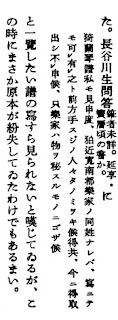物部茂卿 (もののべう もけい) Monobe Mokei 即 荻生徂徠 (おぎゅう そらい) Ogyū Sorai (1666–1728) 寫於享保七年壬寅(1722)四月二十八日
試著翻成中文
茂卿,生於東(京),足跡遍及關西及其他地方,卻不知曉堂上音樂家的秘傳。 僅僅學習和聆聽了一兩次的樂曲技巧,所知有限。 品味異國之書,愚者之得,雖然在心中深思熟慮,卻常感到不如意,困擾之情多矣。即使在這個世界中,期望像揚州鶴一樣完美無缺的事物,也是困難重重。精通音樂的人對文字感到陌生,精通文字的人卻不喜好音樂. 即便喜好,亦與學術傳統相悖。在後世的說法中感到困惑,如果不回歸到古老的事物的話,則無法找到解決之道。即便在這太平百年之際,各行各業皆興盛之時,然琴藝之事鮮有人知,感到非常悲傷。 雖然有許多相違背的事情發生,然而留下了文字記錄, 成為有志之人的階梯,思考的指南, 粗淺地加以記載,最終贈予狛氏。
English translation
Mokei, born in the East, left traces in Kansai and other places. However, the secrets within the residence of the music master remain unknown. I, having only acquired a modest proficiency in music skills, derive joy from foreign books and have gained something, albeit as a novice. Despite harboring thoughts within, many things still perplex me. Nevertheless, in this world, achieving perfection is as challenging as the story of the crane in Yangzhou. Those skilled in music are often unfamiliar with characters, and those profound in characters may not appreciate music. Even if they do, they frequently clash with academic traditions. In the current confusion of the world, without returning to ancient ways, there seems to be no alternative. Now, with a century of peace passed, and though various disciplines flourish, there is no one addressing matters of the qin. It is disheartening, and conflicts abound. Nonetheless, recording it in a book may serve as a ladder for those with aspirations. In this spirit, I have dared to expand the record and present it to Mr. Komau.
Quoted from 『琴学大意抄』中的 [琴ノ廃レタル故ノ事 ] 篇 the chapter on[The Circumstances Regarding the Abandonment of the Qin ] from [Kingaku Taiishō]
Peiyou wrote in the mid autumn full moon day of 2023. (9/29/2023)
-----------------------------------------------------------
On Oct 18, 2023 Peiyou wrote:
I am very happy to receive the Chinese translation of the Japanese [Yolan] study by Mikiko Yamadera's Research on National Treasure [Jieshi Mode Yolan, The Fifth] from Amazon that I ordered two weeks ago.
Today, I noticed something that requires further examination in relation to the Chinese translation. The Japanese phrase "この時にまさか原本が紛失して ゐたわけでもあるまい" from page 40 of Mikiko's book, should translate as "At this time, it's hardly likely that the original manuscript has been lost." It expresses skepticism or disbelief about the possibility of the original manuscript being lost at the current moment. In Chinese it will be "此時原譜遺失的可能性幾乎不可能" but not 此時原譜很可能已經遺失 (At this time, it is likely that the original manuscript has been lost.)
* Qin friend Bill Mak says :前面的が表示逆接,然後又有わけ加上あるまい,所以我會理解為“不過原稿不一定是真的遺失了吧“
from page 52 of the Chinese translation book, 中文翻譯 徐樑 陶熠
from page 40 of Mikiko's book
- この時に (kono toki ni): "at this time" or "at this moment"
- まさか (masaka): "unlikely" or "hardly"
- 原本が (genpon ga): "original manuscript"
- 紛失して (fusshitsu shite): "lost" or "misplaced"
- ゐたわけでもあるまい (ita wake de mo aru mai): This part is an archaic or classical expression. In modern Japanese, it would be written as いたわけでもあるまい. This phrase expresses doubt or skepticism about the occurrence of an action or event.
from Chat GPT
My understanding is that the key point is "樂家好秘藏物也" that musicians like to hide valuable items for themselves, so it's unlikely that it was lost but rather intentionally hidden.







